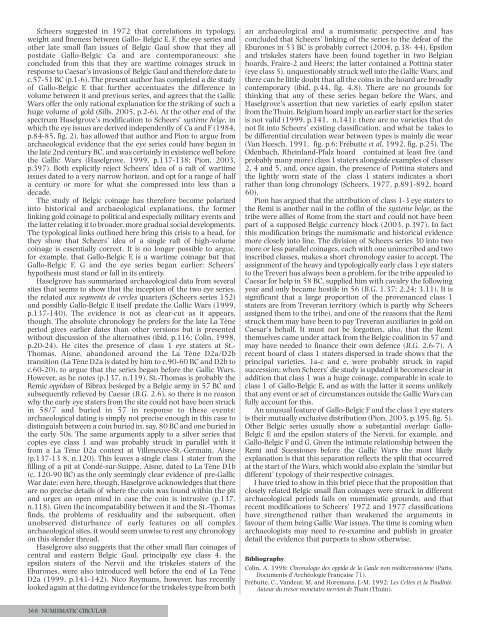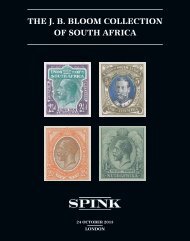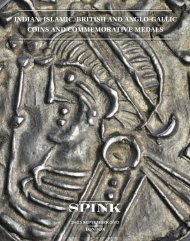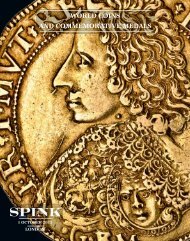Download PDF - Spink
Download PDF - Spink
Download PDF - Spink
- No tags were found...
You also want an ePaper? Increase the reach of your titles
YUMPU automatically turns print PDFs into web optimized ePapers that Google loves.
Dec 05 Editorial 29/11/05 4:27 pm Page 368Scheers suggested in 1972 that correlations in typology,weight and fineness between Gallo- Belgic E, F, the eye series andother late small flan issues of Belgic Gaul show that they allpostdate Gallo-Belgic Ca and are contemporaneous; sheconcluded from this that they are wartime coinages struck inresponse to Caesar’s invasions of Belgic Gaul and therefore date toc.57-51 BC (p.1-6). The present author has completed a die studyof Gallo-Belgic E that further accentuates the difference involume between it and previous series, and agrees that the GallicWars offer the only rational explanation for the striking of such ahuge volume of gold (Sills, 2005, p.2-6). At the other end of thespectrum Haselgrove’s modification to Scheers’ système belge, inwhich the eye issues are derived independently of Ca and F (1984,p.84-85, fig. 2), has allowed that author and Pion to argue fromarchaeological evidence that the eye series could have begun inthe late 2nd century BC, and was certainly in existence well beforethe Gallic Wars (Haselgrove, 1999, p.137-138; Pion, 2003,p.397). Both explicitly reject Scheers’ idea of a raft of wartimeissues dated to a very narrow horizon, and opt for a range of halfa century or more for what she compressed into less than adecade.The study of Belgic coinage has therefore become polarizedinto historical and archaeological explanations, the formerlinking gold coinage to political and especially military events andthe latter relating it to broader, more gradual social developments.The typological links outlined here bring this crisis to a head, forthey show that Scheers’ idea of a single raft of high-volumecoinage is essentially correct. It is no longer possible to argue,for example, that Gallo-Belgic E is a wartime coinage but thatGallo-Belgic F, G and the eye series began earlier: Scheers’hypothesis must stand or fall in its entirety.Haselgrove has summarized archaeological data from severalsites that seems to show that the inception of the two eye series,the related aux segments de cercles quarters (Scheers series 152)and possibly Gallo-Belgic E itself predate the Gallic Wars (1999,p.137-140). The evidence is not as clear-cut as it appears,though. The absolute chronology he prefers for the late La Tèneperiod gives earlier dates than other versions but is presentedwithout discussion of the alternatives (ibid, p.116; Colin, 1998,p.20-24). He cites the presence of class 1 eye staters at St.-Thomas, Aisne, abandoned around the La Tène D2a/D2btransition (La Tène D2a is dated by him to c.90-60 BC and D2b toc.60-20), to argue that the series began before the Gallic Wars.However, as he notes (p.137, n.119), St.-Thomas is probably theRemic oppidum of Bibrax besieged by a Belgic army in 57 BC andsubsequently relieved by Caesar (B.G. 2.6), so there is no reasonwhy the early eye staters from the site could not have been struckin 58/7 and buried in 57 in response to these events:archaeological dating is simply not precise enough in this case todistinguish between a coin buried in, say, 80 BC and one buried inthe early 50s. The same arguments apply to a silver series thatcopies eye class 1 and was probably struck in parallel with itfrom a La Tène D2a context at Villeneuve-St.-Germain, Aisne(p.137-13 8, n.120). This leaves a single class 1 stater from thefilling of a pit at Condé-sur-Suippe, Aisne, dated to La Tène D1b(c. 120-90 BC) as the only seemingly clear evidence of pre-GallicWar date; even here, though, Haselgrove acknowledges that thereare no precise details of where the coin was found within the pitand urges an open mind in case the coin is intrusive (p.137,n.118). Given the incompatability between it and the St.-Thomasfinds, the problems of residuality and the subsequent, oftenunobserved disturbance of early features on all complexarchaeological sites, it would seem unwise to rest any chronologyon this slender thread.Haselgrove also suggests that the other small flan coinages ofcentral and eastern Belgic Gaul, principally eye class 4, theepsilon staters of the Nervii and the triskeles staters of theEburones, were also introduced well before the end of La TèneD2a (1999, p.141-142). Nico Roymans, however, has recentlylooked again at the dating evidence for the triskeles type from bothan archaeological and a numismatic perspective and hasconcluded that Scheers’ linking of the series to the defeat of theEburones in 53 BC is probably correct (2004, p.38- 44). Epsilonand triskeles staters have been found together in two Belgianhoards, Fraire-2 and Heers; the latter contained a Pottina stater(eye class 5), unquestionably struck well into the Gallic Wars, andthere can be little doubt that all the coins in the hoard are broadlycontemporary (ibid, p.44, fig. 4.8). There are no grounds forthinking that any of these series began before the Wars, andHaselgrove’s assertion that new varieties of early epsilon staterfrom the Thuin, Belgium hoard imply an earlier start for the seriesis not valid (1999, p.141, n.141): there are no varieties that donot fit into Scheers’ existing classification, and what he takes tobe differential circulation wear between types is mainly die wear(Van Heesch, 1991, fig. p.6; Frébutte et al, 1992, fig. p.25). TheOdenbach, Rheinland-Pfalz hoard contained at least five (andprobably many more) class 1 staters alongside examples of classes2, 4 and 5, and, once again, the presence of Pottina staters andthe lightly worn state of the class 1 staters indicates a shortrather than long chronology (Scheers, 1977, p,891-892, hoard60).Pion has argued that the attribution of class 1-3 eye staters tothe Remi is another nail in the coffin of the système belge, as thetribe were allies of Rome from the start and could not have beenpart of a supposed Belgic currency block (2003, p.397). In factthis modification brings the numismatic and historical evidencemore closely into line. The division of Scheers series 30 into twomore or less parallel coinages, each with one uninscribed and twoinscribed classes, makes a short chronology easier to accept. Theassignment of the heavy and typologically early class 1 eye statersto the Treveri has always been a problem, for the tribe appealed toCaesar for help in 58 BC, supplied him with cavalry the followingyear and only became hostile in 56 (B.G. 1.37; 2.24; 3.11). It issignificant that a large proportion of the provenanced class 1staters are from Treveran territory (which is partly why Scheersassigned them to the tribe), and one of the reasons that the Remistruck them may have been to pay Treveran auxiliaries in gold onCaesar’s behalf. It must not be forgotten, also, that the Remithemselves came under attack from the Belgic coalition in 57 andmay have needed to finance their own defence (B.G. 2.6-7). Arecent hoard of class 1 staters dispersed in trade shows that theprincipal varieties, 1a-c and e, were probably struck in rapidsuccession; when Scheers’ die study is updated it becomes clear inaddition that class 1 was a huge coinage, comparable in scale toclass 1 of Gallo-Belgic E, and as with the latter it seems unlikelythat any event or set of circumstances outside the Gallic Wars canfully account for this.An unusual feature of Gallo-Belgic F and the class 1 eye statersis their mutually exclusive distribution (Pion, 2003, p.395, fig. 5).Other Belgic series usually show a substantial overlap: Gallo-Belgic E and the epsilon staters of the Nervii, for example, andGallo-Belgic F and G. Given the intimate relationship between theRemi and Suessiones before the Gallic Wars the most likelyexplanation is that this separation reflects the split that occurredat the start of the Wars, which would also explain the ‘similar butdifferent’ typology of their respective coinages.I have tried to show in this brief piece that the proposition thatclosely related Belgic small flan coinages were struck in differentarchaeological periods fails on numismatic grounds, and thatrecent modifications to Scheers’ 1972 and 1977 classificationshave strengthened rather than weakened the arguments infavour of them being Gallic War issues. The time is coming whenarchaeologists may need to re-examine and publish in greaterdetail the evidence that purports to show otherwise.BibliographyColin, A. 1998: Chronologie des oppida de la Gaule non méditerranéenne (Paris,Documents d’Archéologie Française 71).Frébutte, C., Vandeur, M. and Horemans, J.-M. 1992: Les Celtes et la Thudinie.Autour du trésor monétaire nervien de Thuin (Thuin).368 NUMISMATIC CIRCULAR

















